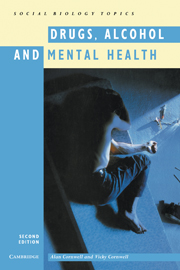Book contents
- Frontmatter
- Contents
- Preface
- 1 Drugs and drug abuse
- 2 Socially acceptable drugs
- 3 Misuse of prescribed and related drugs
- 4 Hallucinogenic drugs
- 5 Opiates and other narcotics
- 6 The biology of alcohol
- 7 The problems of alcohol use
- 8 Prevention and control of alcohol problems
- 9 Help for problem drinkers
- 10 Mental health and mental illness
- 11 Alzheimer's disease and other dementias
- 12 Other mental illnesses
- Further reading
- Index
3 - Misuse of prescribed and related drugs
Published online by Cambridge University Press: 05 June 2012
- Frontmatter
- Contents
- Preface
- 1 Drugs and drug abuse
- 2 Socially acceptable drugs
- 3 Misuse of prescribed and related drugs
- 4 Hallucinogenic drugs
- 5 Opiates and other narcotics
- 6 The biology of alcohol
- 7 The problems of alcohol use
- 8 Prevention and control of alcohol problems
- 9 Help for problem drinkers
- 10 Mental health and mental illness
- 11 Alzheimer's disease and other dementias
- 12 Other mental illnesses
- Further reading
- Index
Summary
Introduction
There are many drugs prescribed which are addictive and are also used for non-medical purposes. There are two aspects to the problem of these drugs – the middle-aged and elderly who have become dependent as a result of over-prescription, and the young who obtain them illegally and use them as mood changing agents. Three main groups of drugs need to be considered, hypnotics (sleep-inducing agents), sedatives (minor tranquilisers) and stimulants.
Hypnotics and minor tranquilisers
By definition, hypnotics are sleep inducers whilst sedatives are used to quieten or reduce anxiety without inducing sleep. In a sense, the sub-division is artificial as the difference in action is often due to the dose level or the setting in which the drug is used.
Barbiturates
The chemical barbituric acid was first synthesised in 1864 by von Baeyer and, although not itself a depressant of the central nervous system, it is the parent of a large number of drugs which have depressant properties. Of the 2500 derivatives which have been prepared, about 50 have been used clinically. The main way in which they vary is in the length of time over which they are active. Some examples are given in table 3.1.
Phenobarbitone is little used now except sometimes as an anti-convulsive to control epilepsy.
Pentothal is used as a premedication for surgery and also as an intravenous dental anaesthetic.
The main problems are from the medium-term barbiturates. These have been widely used as sleeping tablets and they are the ones favoured by illegal users.
- Type
- Chapter
- Information
- Drugs, Alcohol and Mental Health , pp. 19 - 28Publisher: Cambridge University PressPrint publication year: 1993



